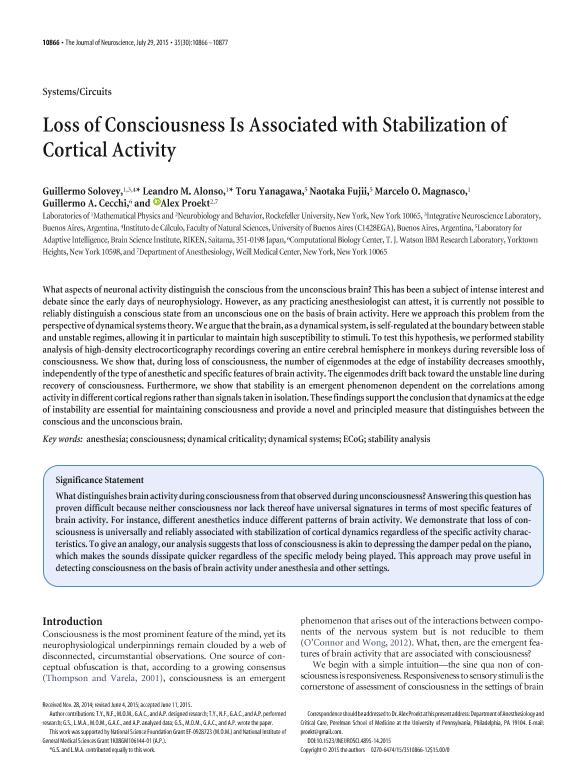Artículo
Loss of consciousness is associated with stabilization of cortical activity
Solovey, Guillermo ; Alonso, Leandro Martín
; Alonso, Leandro Martín ; Yanagawa, Toru; Fujii, Naotaka; Magnasco, Marcelo Osvaldo; Cecchi, Guillermo Alberto; Proekt, Alex
; Yanagawa, Toru; Fujii, Naotaka; Magnasco, Marcelo Osvaldo; Cecchi, Guillermo Alberto; Proekt, Alex
 ; Alonso, Leandro Martín
; Alonso, Leandro Martín ; Yanagawa, Toru; Fujii, Naotaka; Magnasco, Marcelo Osvaldo; Cecchi, Guillermo Alberto; Proekt, Alex
; Yanagawa, Toru; Fujii, Naotaka; Magnasco, Marcelo Osvaldo; Cecchi, Guillermo Alberto; Proekt, Alex
Fecha de publicación:
07/2015
Editorial:
Society for Neuroscience
Revista:
Journal of Neuroscience
ISSN:
0270-6474
Idioma:
Inglés
Tipo de recurso:
Artículo publicado
Clasificación temática:
Resumen
What aspects of neuronal activity distinguish the conscious from the unconscious brain? This has been a subject of intense interest and debate since the early days of neurophysiology. However, as any practicing anesthesiologist can attest, it is currently not possible to reliably distinguish a conscious state from an unconscious one on the basis of brain activity. Here we approach this problem from the perspective of dynamical systems theory. We argue that the brain, as a dynamical system, is self-regulated at the boundary between stable and unstable regimes, allowing it in particular to maintain high susceptibility to stimuli. To test this hypothesis, we performed stability analysis of high-density electrocorticography recordings covering an entire cerebral hemisphere in monkeys during reversible loss of consciousness. We show that, during loss of consciousness, the number of eigenmodes at the edge of instability decreases smoothly, independently of the type of anesthetic and specific features of brain activity. The eigenmodes drift back toward the unstable line during recovery of consciousness. Furthermore, we show that stability is an emergent phenomenon dependent on the correlations among activity in different cortical regions rather than signals taken in isolation. These findings support the conclusion that dynamics at the edge of instability are essential for maintaining consciousness and provide a novel and principled measure that distinguishes between the conscious and the unconscious brain. Significance Statement: What distinguishes brain activity during consciousness from that observed during unconsciousness? Answering this question has proven difficult because neither consciousness nor lack thereof have universal signatures in terms of most specific features of brain activity. For instance, different anesthetics induce different patterns of brain activity. We demonstrate that loss of consciousness is universally and reliably associated with stabilization of cortical dynamics regardless of the specific activity characteristics. To give an analogy, our analysis suggests that loss of consciousness is akin to depressing the damper pedal on the piano, which makes the sounds dissipate quicker regardless of the specific melody being played. This approach may prove useful in detecting consciousness on the basis of brain activity under anesthesia and other settings.
Archivos asociados
Licencia
Identificadores
Colecciones
Articulos(OCA CIUDAD UNIVERSITARIA)
Articulos de OFICINA DE COORDINACION ADMINISTRATIVA CIUDAD UNIVERSITARIA
Articulos de OFICINA DE COORDINACION ADMINISTRATIVA CIUDAD UNIVERSITARIA
Citación
Solovey, Guillermo; Alonso, Leandro Martín; Yanagawa, Toru; Fujii, Naotaka; Magnasco, Marcelo Osvaldo; et al.; Loss of consciousness is associated with stabilization of cortical activity; Society for Neuroscience; Journal of Neuroscience; 35; 30; 7-2015; 10866-10877
Compartir
Altmétricas



